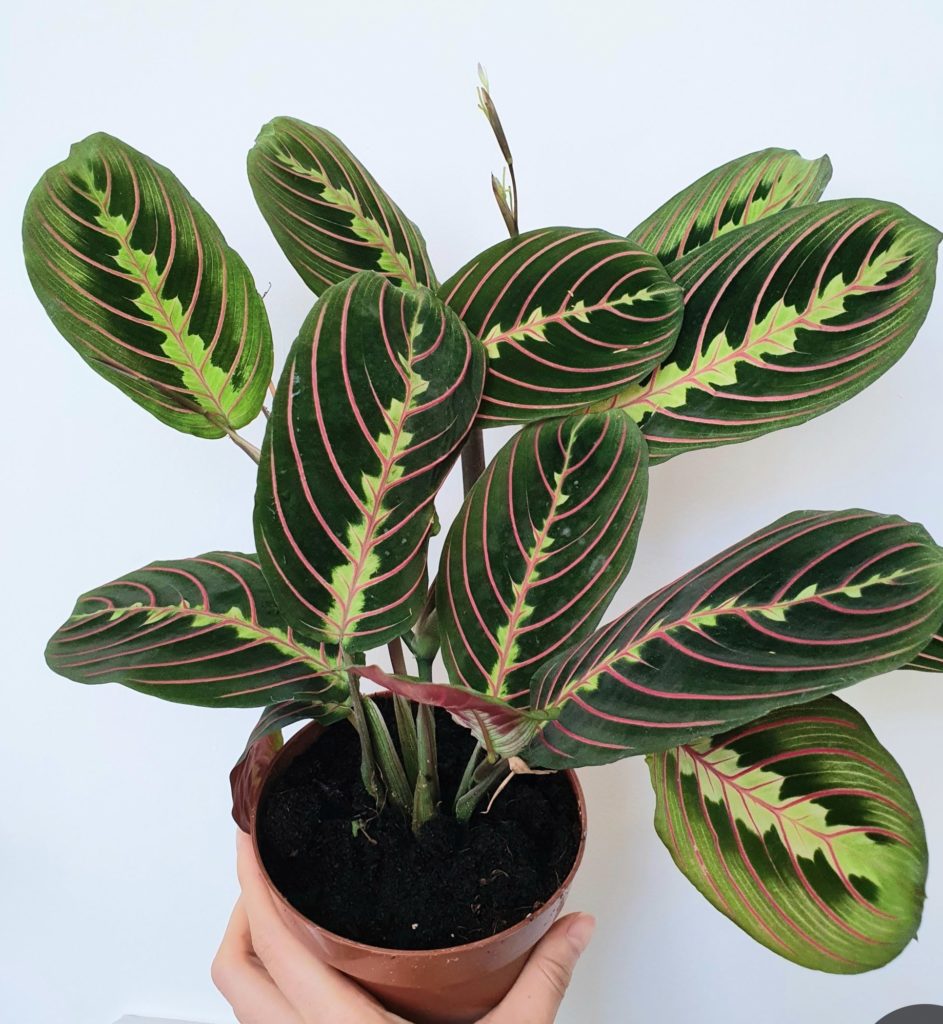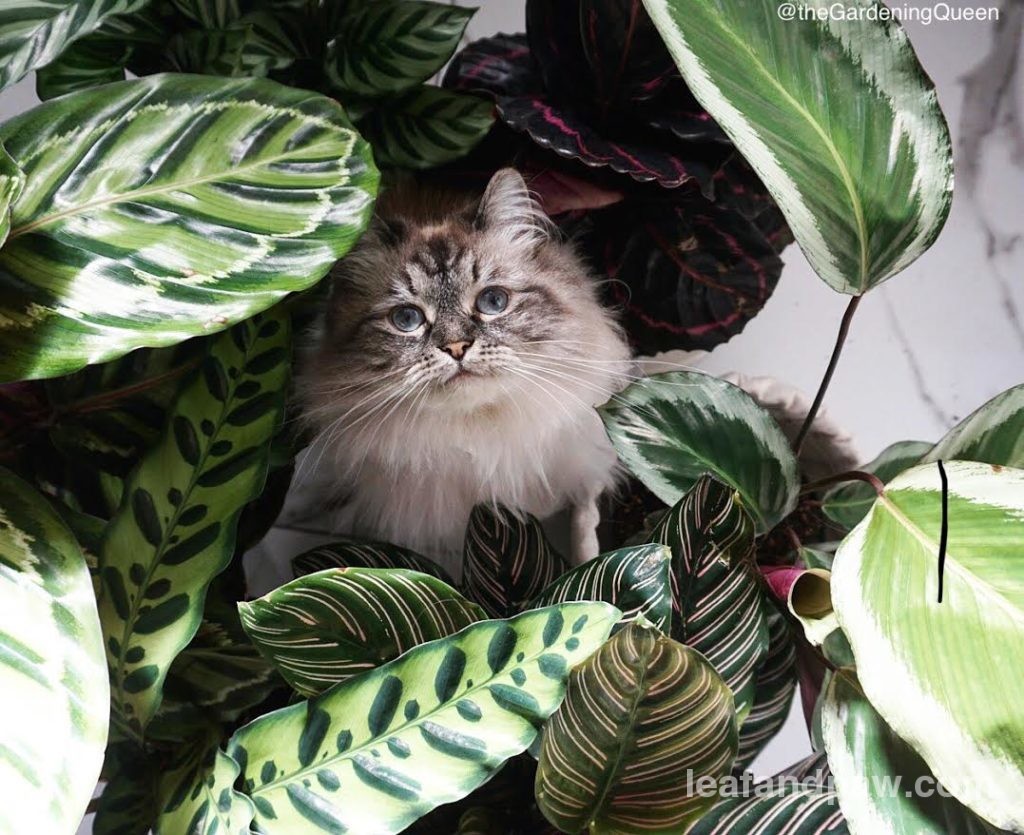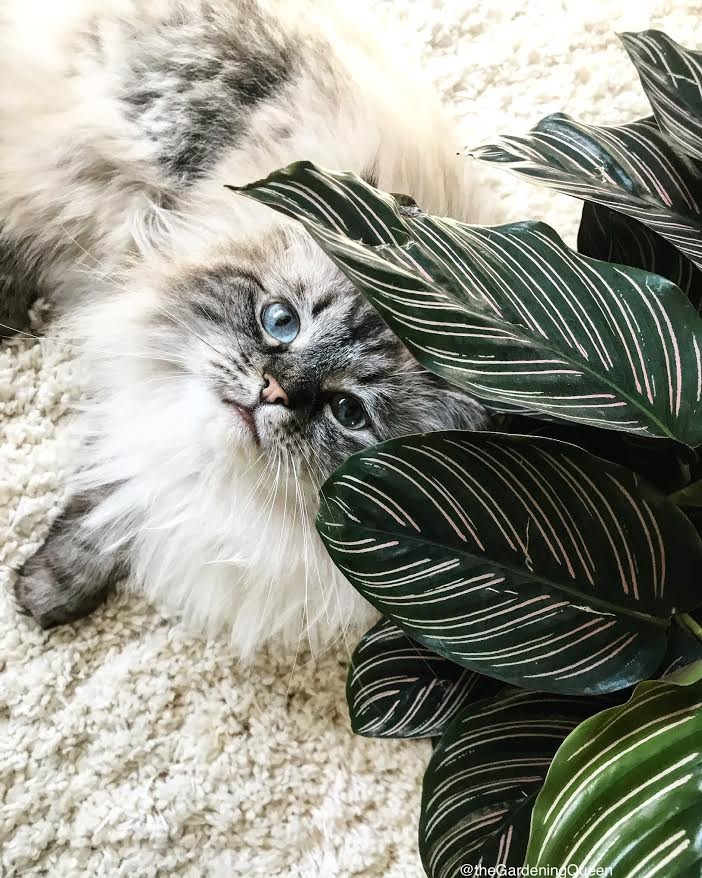Key Takeaways
- Calathea plants are non-toxic to both cats and dogs, making them a safe choice for pet owners.
- There are various Calathea varieties, each with unique leaf patterns and colors.
- Proper care involves maintaining high humidity, consistent watering, and indirect light.
- Calathea plants can thrive both indoors and outdoors, given the right conditions.
- Reviving a Calathea after pet damage involves pruning damaged leaves and adjusting care routines.
Calathea and Pets: A Pet-Friendly Plant Choice
When it comes to selecting houseplants, many pet owners are rightfully cautious about the safety of their furry companions. The good news is, Calathea plants are not only beautiful but also safe for pets. They are non-toxic to both cats and dogs, which means you can enjoy their lush, vibrant foliage without worrying about your pets’ health.
Calathea, with its striking leaves and air-purifying qualities, is an excellent choice for homes with pets. This plant is known for its ability to add a touch of the tropics to any space while keeping your pets safe. According to the ASPCA, Calathea is listed among non-toxic plants, ensuring peace of mind for pet owners.
“Cat friendly indoor plants – Discover …” from www.secretgardenivy.com and used with no modifications.
Identifying Calathea Varieties
Calathea plants come in various stunning varieties, each offering unique patterns and colors. From the bold stripes of the Calathea zebrina to the intricate designs of the Calathea ornata, there’s a type for every aesthetic preference.
Identifying these varieties is crucial for understanding their specific care needs. For instance, some Calatheas may prefer more shade, while others thrive in brighter, indirect light. Knowing your plant’s variety can help tailor your care approach, ensuring your Calathea remains healthy and vibrant.
Calathea Care Indoors vs Outdoors
Calathea plants are versatile and can thrive both indoors and outdoors, provided the conditions are right. Indoors, they prefer a spot with indirect light, as direct sunlight can scorch their delicate leaves. Outdoors, a shaded patio or garden area can be ideal, as long as the environment remains humid and warm.
When caring for Calathea outdoors, it’s important to mimic their natural tropical habitat. This means ensuring they are not exposed to cold drafts or sudden temperature changes. Indoors, maintaining high humidity can be achieved by placing a humidifier nearby or misting the leaves regularly.
Optimal Placement for Your Calathea
Finding the perfect spot for your Calathea can make all the difference in its growth and health. Ideally, place it in a location with filtered light, such as near a north or east-facing window. Avoid placing it in direct sunlight, which can lead to leaf burn and discoloration.
Besides light, consider the room’s humidity level. Bathrooms or kitchens, which naturally have higher humidity, can be great spots for Calathea. If your home is on the drier side, consider using a pebble tray with water under the plant pot to increase humidity around the plant.
Importance of Humidity and Temperature
Calathea plants thrive in high humidity and warm temperatures, reflecting their tropical origins. Maintaining the right humidity is crucial, as dry air can lead to browning leaf edges and curling. Ideally, the humidity level should be above 50%. If your home tends to be dry, especially during winter, consider using a humidifier to keep the air moist.
Temperature is equally important. Calathea prefers a consistent range between 65°F to 80°F. Sudden drops in temperature or exposure to cold drafts can stress the plant, causing the leaves to droop or discolor. Therefore, it’s best to keep your Calathea away from air conditioning vents or open windows during chilly weather.
Pruning and Repotting Practices
Pruning is an essential part of Calathea care. Regularly remove any yellow or brown leaves to encourage new growth and maintain the plant’s aesthetic appeal. Use clean, sharp scissors to make clean cuts, which helps prevent disease.
Repotting is typically needed every two years or when you notice the plant has outgrown its current pot. Choose a pot that’s one size larger and use fresh potting soil. Repotting not only gives the plant more space to grow but also refreshes the soil, providing essential nutrients.
Pet Safety and Calathea: Facts to Know
One of the most appealing aspects of Calathea plants is their non-toxic nature. This makes them an excellent choice for households with pets. While some plants pose risks to pets, Calathea does not, allowing you to enjoy its beauty without concern.
“A Guide to Collecting Calathea …” from leafandpaw.com and used with no modifications.
Calathea’s Impact on Cats
Cats are known for their curiosity, and many enjoy nibbling on houseplants. Fortunately, Calathea is safe for cats. If your feline friend decides to take a bite, there’s no need to worry about toxicity. However, excessive chewing can damage the plant.
It’s wise to place your Calathea in a spot that’s not easily accessible to your cat. This not only protects the plant but also minimizes the risk of soil being scattered or the pot being knocked over.
Encouraging your cat to focus on their toys or providing cat grass can also help deter them from targeting your houseplants. These alternatives satisfy their urge to chew and explore.
Is It Safe for Dogs?
Calathea plants are equally safe for dogs. Unlike some houseplants that can cause vomiting or worse symptoms in dogs, Calathea poses no such threat. This makes it a worry-free addition to any dog-friendly home.
While it’s non-toxic, it’s still a good idea to discourage your dog from chewing on the plant. Chewing can damage the leaves and affect the plant’s overall health. Training your dog to respect plant boundaries can be beneficial.
ASPCA Inclusion in Non-Toxic Plants List
The ASPCA (American Society for the Prevention of Cruelty to Animals) lists Calathea among the non-toxic plants for both cats and dogs. This endorsement provides additional assurance for pet owners who want to ensure their homes are safe environments.
Being informed about plant safety is crucial, and the ASPCA’s list is a reliable resource. It helps pet owners make informed decisions when selecting plants, ensuring that their pets are safe and their homes are filled with lush greenery.
Reviving Calathea After Pet Damage
Even with the best precautions, pets might occasionally damage your Calathea. Whether it’s a few chewed leaves or a toppled pot, there are steps you can take to revive your plant. For more information on pet-safe plants, consider exploring ASPCA non-toxic plant care tips.
Steps to Address Leaf Damage
If your Calathea has suffered leaf damage, start by assessing the extent of the harm. Remove any leaves that are beyond repair to prevent the plant from expending energy on them. Use clean scissors to make precise cuts at the base of the leaf stem.
After pruning, ensure your plant is in optimal conditions for recovery. This means checking humidity levels, watering consistently, and providing the right amount of light. With time and proper care, your Calathea can bounce back to its former glory. For more information on maintaining pet-safe plants, consider exploring the care tips for pet-safe gardens.
Nurturing a Chewed Plant Back to Health
If your Calathea has been chewed by a curious pet, don’t panic. Start by carefully inspecting the plant for damage. Remove any leaves that are severely damaged or chewed beyond recovery. This helps the plant focus its energy on healthy growth.
Next, ensure the plant is in a suitable environment to promote healing. Consistent watering, adequate humidity, and proper lighting are crucial. You might also consider using a diluted fertilizer to provide extra nutrients and support recovery.
“A Guide to Collecting Calathea …” from leafandpaw.com and used with no modifications.
Preventing Future Pet-Induced Damage
Prevention is always better than cure, especially when it comes to protecting your plants from pets. To keep your Calathea safe, consider placing it in a location that’s less accessible to your pets, such as a high shelf or a room they don’t frequent.
Training your pets can also be beneficial. Encourage them to focus on their toys or provide alternative plants like cat grass for them to chew. Consistent reinforcement can help them understand which areas are off-limits.
Frequently Asked Questions (FAQ)
Many pet owners have questions about Calathea care and safety. For example, you might wonder if other non-toxic plants are safe for your pets. Here are some of the most common inquiries and answers to help you keep your plants and pets healthy and happy.
“11 Gorgeous Calathea Varieties (with …” from growfully.com and used with no modifications.
Are all Calathea varieties non-toxic to pets?
Yes, all Calathea varieties are considered non-toxic to both cats and dogs. This makes them an excellent choice for pet-friendly households. However, it’s still wise to prevent your pets from chewing on the leaves, as this can damage the plant.
- Calathea zebrina
- Calathea ornata
- Calathea makoyana
Each of these varieties offers unique leaf patterns and colors, adding beauty to your home without compromising pet safety.
How often should I water my Calathea plant?
Calathea plants prefer consistently moist soil, but they do not like to be waterlogged. Water your plant when the top inch of soil feels dry to the touch. It’s important to use room-temperature water and ensure proper drainage to prevent root rot.
What environmental conditions are best for Calathea?
Calathea thrives in environments with high humidity and warm temperatures. Aim for humidity levels above 50% and temperatures between 65°F to 80°F. Keep your plant away from direct sunlight and drafts to maintain its health and vibrancy. For more detailed care tips, you can explore this Calathea care guide.
Can Calathea plants thrive indoors and outdoors?
Yes, Calathea plants can thrive both indoors and outdoors, provided the conditions mimic their natural tropical habitat. Indoors, they need indirect light and high humidity. Outdoors, a shaded area with consistent warmth and humidity is ideal.
Example: “I placed my Calathea in the bathroom, where the natural humidity from showers keeps it thriving. It’s been growing beautifully with minimal leaf browning.”
Remember, whether indoors or outdoors, consistency in care is key to keeping your Calathea healthy.
In conclusion, Calathea plants are a perfect choice for pet owners who want to enjoy beautiful foliage without worrying about their pets’ safety. By understanding their care needs and taking preventive measures against pet damage, you can ensure your Calathea remains a vibrant part of your home. Whether indoors or outdoors, these plants can thrive with the right conditions, bringing a touch of the tropics to any space.









